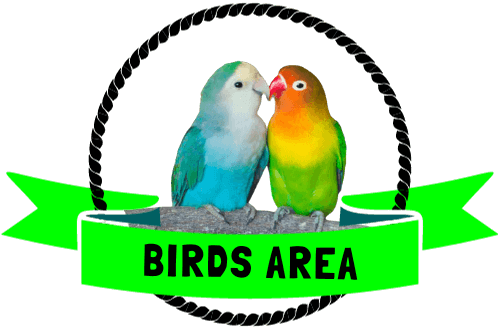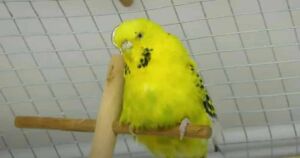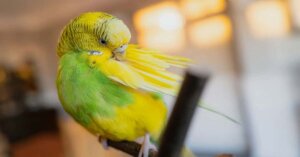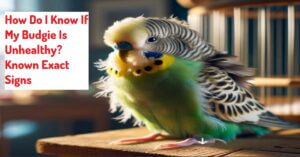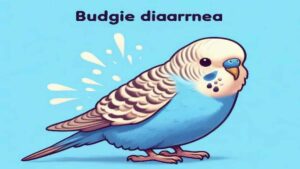Budgie Swollen Bottom | What To Do Now?
A swollen bottom in a budgie could be a cloacal prolapse, which occurs when the vent protrudes out of the body. Budgie swollen bottom can be caused by various factors such as a poor diet, infections, tumors, or egg binding.
However, it is important to accurately diagnose the cause to determine the appropriate treatment for the bird. A swollen bottom in a female budgie can also indicate reproductive tumours or GI problems.
Moreover, this article delves into the issue of a budgie’s swollen bottom, exploring its causes, symptoms, and effective care strategies.
Understanding the Signs: Is Your Budgie’s Bottom Swollen?
Budgies are lively and expressive creatures but don’t always vocalize their discomfort. As a responsible budgie owner, paying attention to subtle signs that something might be amiss is crucial. One such indication is a swollen bottom.
Here, I explore the symptoms that may suggest your budgie’s bottom is swollen and the importance of recognizing these signs promptly.
Recognizing the Symptoms
Budgies communicate distress through changes in behavior and physical appearance. While they may not outright show pain, alterations in their habits can be indicative.
Look out for the following signs:
| Symptom | Description |
|---|---|
| Altered Behavior | Unusual quietness, lethargy, or a noticeable change in temperament. |
| Changes in Droppings | Irregularities in droppings, including alterations in color, consistency, or frequency. |
| Feather Plucking | Signs of stress or discomfort, such as feather plucking, bald patches, or excessive preening. |
| Difficulty Perching | Discomfort while perching, exhibited by difficulty balancing on the perch. |
| Tail Bobbing | Rapid or pronounced tail bobbing, which may indicate respiratory issues linked to a swollen bottom. |
Why Is My Budgies Bottom Swollen? 7 Common Causes of Budgie Swollen Bottom
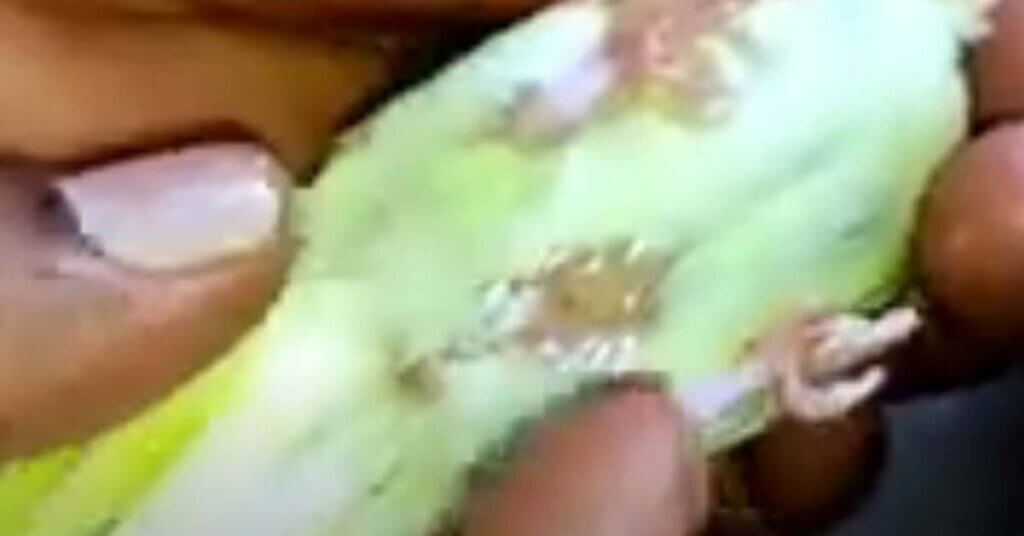
A swollen bottom in budgies can be a sign of various health issues. It is crucial to monitor your budgie’s overall behavior and look for additional symptoms to determine the cause of the swelling.
Here are some possible reasons for a budgie’s swollen bottom:
- Egg Binding: Female budgies may develop egg-binding, where an egg gets stuck in the reproductive tract. This can cause swelling in the bottom area.
- Tumors or Growths: Tumors or abnormal vent area growth can lead to swelling. These growths can be benign or malignant and require veterinary examination.
- Infections: Infections, such as cloacitis (inflammation of the cloaca), can cause swelling and discomfort in the bottom area. Bacterial or fungal infections can also contribute to swelling. The most common cause of budgie swollen bottom is a bacterial infection such as E. coli or Staphylococcus. These bacteria can enter the vent by contacting contaminated food, water, or faeces.
- Injury or Trauma: If your budgie has experienced any injury or trauma to the vent area, it may result in swelling.
- Prolapse: Budgies can experience prolapse, where the cloaca protrudes from the body. This condition can cause swelling and requires immediate veterinary attention.
- Nutritional Deficiencies: A diet lacking essential nutrients, particularly vitamin A and vitamin E, can lead to a weakened immune system and make buds more susceptible to infections, including swollen bottoms.
- Diarrhea: Excessive droppings or diarrhea can irritate the vent area and cause swelling. Dietary changes or underlying health issues may be the cause.
If you notice your budgie’s bottom is swollen, it is best to consult a veterinarian who specializes in avian care. They can properly diagnose and recommend appropriate treatment for your budgie’s specific condition.
Taking Action: Care and Treatment for Budgies with Swollen Bottoms
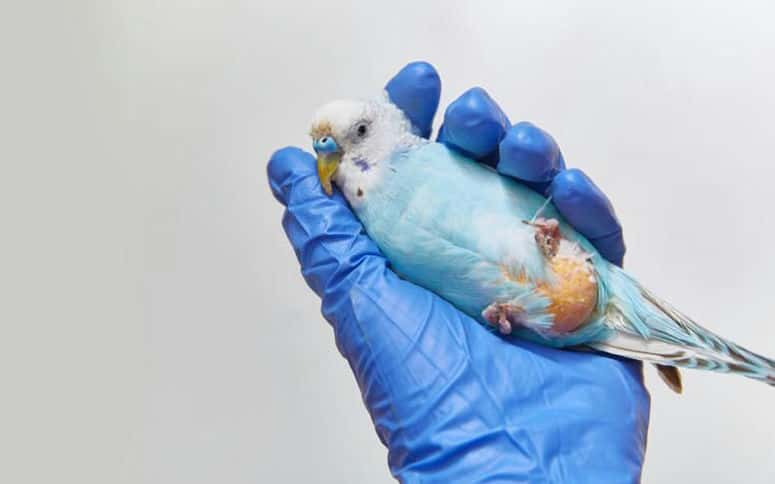
When faced with a swollen bottom in your budgie, immediate and appropriate action is paramount.
This section outlines the steps to take for the care and treatment of your feathered friend, encompassing preventive measures, home care, and crucial considerations when consulting a vet.
Preventive Measures
To safeguard your budgie’s health, implement preventive strategies:
- Ensure a Well-Balanced Diet: Provide a varied and nutritionally balanced diet comprising seeds, pellets, fresh fruits, and vegetables.
- Maintain Hygiene and Cleanliness: Regularly clean the cage, change water frequently, and uphold a sanitary environment to prevent potential infections.
- Regular Veterinary Check-ups: Schedule routine check-ups with an avian vet to detect and address potential health issues at their early stages.
Home Care for Budgies with Swollen Bottoms
Should you suspect a swollen bottom, adopting proper home care measures is crucial:
Isolation if Necessary: If advised by the vet, isolate the affected budgie to prevent the potential spread of infections.
Adjustments to Diet and Environment: Modify the diet as per the vet’s recommendations and make necessary environmental adjustments to reduce stress.
Monitoring Progress: Keep a vigilant eye on your budgie’s progress, noting any changes in behavior, droppings, or overall well-being.
When to Consult a Vet
Certain signs necessitate immediate veterinary attention:
- Labored Breathing: Rapid or irregular breathing patterns can signify respiratory distress and require urgent evaluation.
- Inability to Perch: If your budgie is unable to perch comfortably, it’s a clear indication of distress that warrants prompt attention.
- Loss of Appetite: A sudden loss of interest in food could indicate various underlying health issues and should be addressed swiftly.
Guiding Your Budgie to Recovery: Treatment Options and Emotional Well-being
Navigating your budgie’s recovery involves a combination of medical care and emotional support:
Medications Prescribed by the Vet: Adhere closely to the vet’s prescription, ensuring timely and accurate administration of any prescribed medications.
Surgical Interventions: In severe cases, surgical procedures may be recommended by the vet to address underlying health issues.
Rehabilitation and Recovery Tips: Create a quiet and comfortable space for your budgie’s recovery, offering favorite treats and toys to provide emotional support during healing.
Every budgie is unique, and treatment plans may vary. Following the vet’s guidance diligently is imperative, providing the necessary care and attention for a smooth and successful recovery.
Additional Budgie Swollen Bottom Recovery Tips
It is crucial to promptly address budgie’s swollen bottom to prevent further complications and discomfort for your feathered friend.
Here are some additional tips to aid in the recovery and overall well-being of your budgie:
- Quarantine and separate affected budgies: If you have multiple budgies and one suffers from a swollen bottom, it is essential to isolate the affected bird. This helps prevent the spread of infection to other healthy budgies.
- Provide a warm and clean environment: Ensure the cage or aviary is clean and hygienic. Regularly remove droppings and soiled bedding to maintain a clean living space for your budgie. Additionally, maintaining a warm and draft-free environment can promote healing and comfort.
- Administer prescribed medication: Follow your veterinarian’s instructions regarding the antibiotics or medications prescribed for your budgie. Completing the entire treatment course is crucial to ensuring the infection is eradicated.
- Encourage proper hygiene: In some cases, gently cleaning the affected area with warm water and a mild antiseptic solution may be necessary. However, always consult your veterinarian before attempting any cleaning procedures.
- Optimize diet and nutrition: A balanced and nutritious diet is vital for your budgie’s overall health and immunity. Provide a varied diet consisting of high-quality pellets, fresh vegetables, fruits, and the occasional treat. Consult an avian veterinarian or an avian nutritionist for suitable dietary choices.
- Stress reduction: Minimize stress factors in your budgie’s environment, as stress can compromise their immune system. Provide plenty of mental stimulation, toys, and a comfortable resting area for your budgie to relax.
- Regular veterinary check-ups: Schedule regular check-ups with an avian veterinarian to monitor your budgie’s health and promptly address any underlying health issues.
Remember, budgie’s swollen bottom can be a symptom of an underlying health problem, so addressing the condition’s root cause is essential.
By providing proper care, hygiene, and veterinary attention, you can help your budgie recover and maintain a happy and healthy life.
Frequently Asked Questions On Budgie Swollen Bottom
What Is A Lump On A Budgie’s Bottom?
A lump on a budgie’s bottom could signify cloacal prolapse when the vent is pushed outward and becomes swollen and red. Other possible causes include poor diet, infections, tumors, and egg binding. It is crucial to get a proper diagnosis for appropriate treatment.
Why Has My Budgie Got A Dirty Bum?
A dirty bum in a budgie could indicate a cloacal prolapse, which is when the vent protrudes from the body. This can be caused by various factors such as poor diet, parasites, infections, tumors, or egg binding. It’s important to identify the cause for accurate treatment.
Why Is My Budgie Sitting Puffed Up?
A budgie sitting puffed up is likely in distress or feeling sick. They fluff up their feathers to keep warm or when they relax for sleep. It can be a sign of illness if the bird sits puffed up for most of the day, especially if there is tail-bobbing when breathing.
Seek veterinary attention if you notice these symptoms.
Final Overviews
To conclude, a swollen bottom in budgies can cause concern. It may indicate a cloacal prolapse, which can be caused by various factors such as poor diet, infections, parasites, tumors, or egg binding.
However, seeking veterinary attention for an accurate diagnosis and appropriate treatment is essential.
Please don’t ignore this symptom; take care of your budgie’s health to ensure their well-being.
Hello Dear, I'm Poli Kolymnia, owner of many birds (including budgies).
With a deep passion for these feathered companions, I'm here to share my expertise and extensive knowledge on birds care.
My articles cover essential topics like diet, housing, care, and health, providing practical tips to help you create a happy and thriving environment for your birds.
